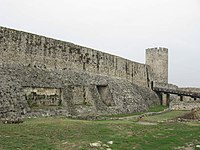Danubian Limes
Due to the boggy and dendritic nature of the Danube's river banks no border ramparts were built, unlike the Neckar-Odenwald Limes in Germany.
Fourteen kilometres away to the west an auxiliary fort (Hilfskastell) was built near Schlögen (today in the municipality of Haibach ob der Donau) in Upper Austria.
The increasing number of fortifications that were falling into decay were renovated again under Emperor Valentinian I (364–375) and upgraded to the conform to the latest military tactics.
They finally served during Maurice's Balkan campaigns his successor, Phocas, as a basis for larger military operations and some were maintained in the province of Moesia Secunda until the invasion of the Bulgars in 679.
The Lower Pannonia province ran along the eastern side of the Danube, today a part of Hungary, Serbia, Croatia, and Bosnia and Herzegovina.



